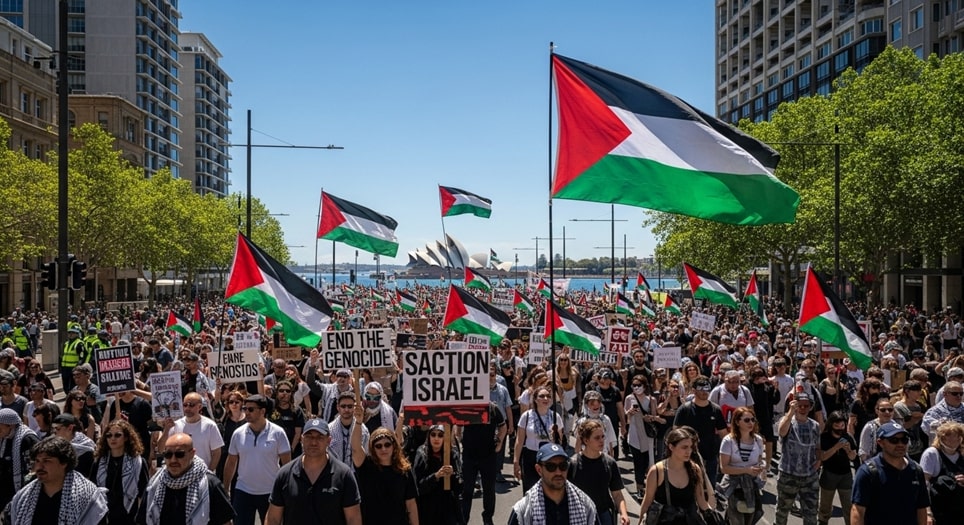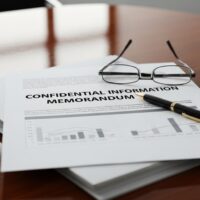
Sydney, Australia – October 12, 2025
Tens of thousands of demonstrators filled the streets of Sydney’s central business district on Sunday, marching in a massive pro-Palestinian rally organized by the Palestine Action Group despite a recent Supreme Court prohibition on converging at the iconic Sydney Opera House. The event, marking the second anniversary of the October 7, 2023, Hamas attacks on Israel that killed approximately 1,200 people, proceeded along an approved alternative route from Hyde Park North down George Street to Belmore Park. Organizers estimated attendance at 30,000, while New South Wales police reported figures closer to 8,000 to 9,000, underscoring the scale of public mobilization amid a fragile U.S.-brokered ceasefire in Gaza.
The rally unfolded peacefully under a heavy police presence, with participants waving Palestinian flags, beating drums, and chanting slogans demanding an end to the Israeli occupation. This demonstration formed part of approximately 27 nationwide actions across Australia, reflecting sustained civil society engagement two years into the conflict that has claimed over 67,000 lives in Gaza according to local authorities. Protesters expressed a mix of cautious hope and deep skepticism regarding the ceasefire’s durability, emphasizing that a pause in hostilities does not address underlying issues of blockade, displacement, and accountability.
Background: The Court Battle and Route Adjustment
Leading up to the rally, the Palestine Action Group faced significant legal hurdles when New South Wales police sought and obtained a prohibition order from the NSW Supreme Court, upheld by the Court of Appeal. The court cited extreme public safety risks, including potential crowd crushes at pinch points along the planned route to the Sydney Opera House forecourt, limited exit options for an anticipated 40,000 attendees, and delays from mandatory security screenings such as bag checks and X-ray machines. NSW Police Assistant Commissioner Peter McKenna described the original plan as having “disaster written all over it,” highlighting insufficient police resources to manage the event securely.
In a landmark ruling, the Court of Appeal, comprising Chief Justice Andrew Bell and Justices Ian Harrison and Stephen Free, declared that anyone with knowledge of the order participating in the prohibited assembly could face contempt charges, with penalties at the court’s discretion. This interpretation marked a significant escalation, as breaching such orders could lead to jail time beyond standard public order offenses. Organizers swiftly adapted, securing approval for the Hyde Park to Belmore Park path, a route familiar from prior weekly protests over the past two years.
The legal victory for police drew criticism from protest advocates, who argued it imposed a chilling effect on democratic expression. Palestine Action Group spokesperson Nick Hanna stated outside court that the fight was not for convenience but principle, warning of broader implications for all public assemblies in Australia, regardless of cause. Greens MP Sue Higginson labeled the approach draconian, though police maintained the form 1 notification system remained a collaborative tool for safe protesting.
The Rally Unfolds: Atmosphere and Participation
By midday, Hyde Park North buzzed with energy as families, students, professionals, and activists gathered under the autumn sun. Stalls distributed keffiyeh scarves, flags, and pamphlets, while speakers blared traditional music blended with protest anthems. Protesters of diverse backgrounds mingled, holding placards reading “Sanction Israel,” “End the Siege,” and “Free Palestine,” their resolve undiminished by the court setback.
At precisely 1 p.m., the procession commenced, snaking southward along bustling George Street. The column stretched for blocks, with rhythmic drumming and unified chants echoing off skyscrapers. Pedestrians paused to observe, some joining spontaneously, as police managed traffic with minimal disruption. The march reached Belmore Park by early afternoon, where speeches continued amid a sea of flags fluttering in the wind.
One minor incident occurred when police arrested a 30-year-old man at the George and Liverpool Streets intersection for possessing a sharpened wooden implement; he was charged at Surry Hills Police Station. Otherwise, the event proceeded without significant disturbances, crediting coordinated efforts between organizers and over 500 officers from specialized units including riot squad, mounted police, and PolAir.
Nationwide Solidarity Actions
Beyond Sydney, synchronized rallies amplified the message across Australia. In Melbourne, hundreds marched from the State Library down St Kilda Road to the U.S. consulate, met by a peaceful counter-protest at the library steps featuring Australian and Israeli flags demanding hostage releases. Brisbane saw about 1,000 participants loop through the central business district from Queens Gardens, chanting “End the Occupation.”
Adelaide demonstrators proceeded from Victoria Square to Parliament House, while smaller gatherings in Hobart, Darwin, Albany, and Broome echoed similar themes. In Perth, Friends of Palestine WA rallied despite logistical challenges. These events highlighted the movement’s breadth, drawing participants from urban centers to regional towns.
Key Speakers and Testimonies
The Hyde Park podium hosted compelling voices, blending personal trauma with calls for justice. Organizers Josh Lees and Amal Naser framed the day as a triumph of resilience. Lees declared, “We said there’d be 10,000; I think there’s at least that number here now, probably more,” emphasizing nationwide turnout. Naser asserted, “Every single time the police attempt to oppose our rallies or take us to the supreme court, it wakes up a lot of people … to the need to mobilise.”
Prominent were four Australian activists recently released from Israeli detention following the interception of the Global Sumud Flotilla, which sought to break Gaza’s naval blockade with aid. Surya McEwen, nursing a dislocated arm from alleged mistreatment, noted uncertainty around ceasefire details but affirmed continued flotilla efforts “as long as there is a situation where there’s a brutal and illegal blockade.” Abubakir Rafiq recounted his ordeal in Ketziot prison: “When I first arrived to prison, I was thrown into a cage 4 by 6 metres with 83 other men,” contrasting his freedom with “10,000 Palestinian hostages” enduring similar fates.
NSW Greens MP Jenny Leong urged resistance to external impositions: “We cannot let a world where Trump determines the future of the Palestinian people to be the kind of world that we live in.” Palestinian Australian Shamikh Badra shared family losses, expressing worry over the “Trump plan imposed on Palestinians” without consultation.
Juliet Lamont vowed renewed flotilla voyages: “Next time we’re going to go back with 150 to 200 boats … Join us because I’m not a very good sailor but I’ve got a fire in my belly.”
Skepticism Amid Ceasefire Hopes
The rallies coincided with the ceasefire’s first phase, involving Israeli troop withdrawals and planned hostage-prisoner exchanges. While some expressed relief, prevailing sentiment urged vigilance. Protester Abbi Jordan told reporters, “This so-called ceasefire will not hold. Israel always breaks every ceasefire they’ve ever done.”
In Brisbane, Aisha Ziad reflected, “Hopefully [the ceasefire] is the start of something good… but it just feels too late.” Adelaide’s Doha Khan deemed it untrustworthy, citing slaughtered healthcare workers. WA Greens MLC Jess Beckerling captured duality: immense relief after “two years of genocide,” yet distrust of mediators like Netanyahu and Trump.
Organizer Amal Naser clarified, “Even if the ceasefire holds, Israel is still conducting a military occupation … constitute an Apartheid system.” The Executive Council of Australian Jewry criticized organizers for desiring the deal’s failure, prolonging suffering.
Core Demands of the Movement
Participants articulated a comprehensive agenda rooted in humanitarian imperatives and long-term equity. The following outlines primary calls, drawn from speeches and signage:
- Enforce and Monitor Ceasefire: Demand international oversight to prevent violations, ensuring sustained halt to bombings and safe aid corridors into devastated Gaza infrastructure.
- Australian Sanctions on Israel: Urge economic measures and termination of bilateral arms trade, aligning foreign policy with human rights standards and pressuring for compliance.
- Lift Gaza Blockade: Call for immediate end to naval and land restrictions, enabling economic recovery, mobility, and reconstruction for 2.3 million residents.
- End Israeli Occupation: Seek withdrawal from West Bank and Gaza, recognizing Palestinian self-determination within 1967 borders as pathway to peace.
- Accountability for Atrocities: Push for International Criminal Court investigations, prosecutions, reparations, and truth mechanisms to address civilian casualties and alleged war crimes.
- Unrestricted Humanitarian Aid: Insist on unimpeded access for UNRWA, UNICEF, and others to combat famine, medical crises, and displacement affecting millions.
- Release All Hostages and Prisoners: Advocate reciprocal exchanges, prioritizing innocents including children, mothers, and fathers held without trial.
- Global Solidarity and Mobilization: Commit to ongoing weekly actions, linking Palestinian struggle to anti-colonial fights worldwide for amplified impact.
Police Response and Public Safety
NSW Police deployed extensive resources, including mounted units, dog squads, and aerial support, to facilitate the approved route while enforcing the Opera House exclusion. Barricades secured the forecourt, with patrols deterring deviations. Assistant Commissioner McKenna praised community cooperation for the incident-free operation, save the single arrest.
This approach contrasted earlier tensions, evolving protocols to balance expression and safety in mass assemblies. Post-event, reviews will refine strategies, affirming Sydney’s capacity for diverse dissent.
In parallel, a Jewish community vigil in Sydney’s eastern suburbs commemorated October 7 victims, with prayers for remaining hostages. Boos greeted mentions of Australian leaders, highlighting polarized narratives.
Implications for Australia’s Protest Landscape
The rallies signal enduring momentum in Australia’s pro-Palestinian movement, influencing parliamentary debates and petitions. Legal challenges, like PAG’s subsequent Supreme Court win striking down anti-protest laws near places of worship, underscore evolving rights dynamics. Organizers plan continued actions, including a Unite Against Racism event, tying Gaza solidarity to domestic anti-fascism.
Media amplification via live streams and social platforms engaged youth, sustaining discourse on empathy and justice. As hostage exchanges loom, focus shifts to reconstruction oversight and diplomatic pressures.
Conclusion
Sunday’s marches across Australia, led by Sydney’s resilient procession, embodied unyielding commitment to Palestinian rights amid ceasefire uncertainties. From court-defying adaptations to poignant flotilla testimonies, participants wove personal anguish with policy imperatives, demanding sanctions, aid, and occupation’s end. Peaceful execution under vigilant policing reinforced democratic vitality, while nationwide solidarity amplified calls for accountability. As echoes of chants linger, the imperative persists: collective vigilance to convert fragile pauses into lasting equity and peace.





